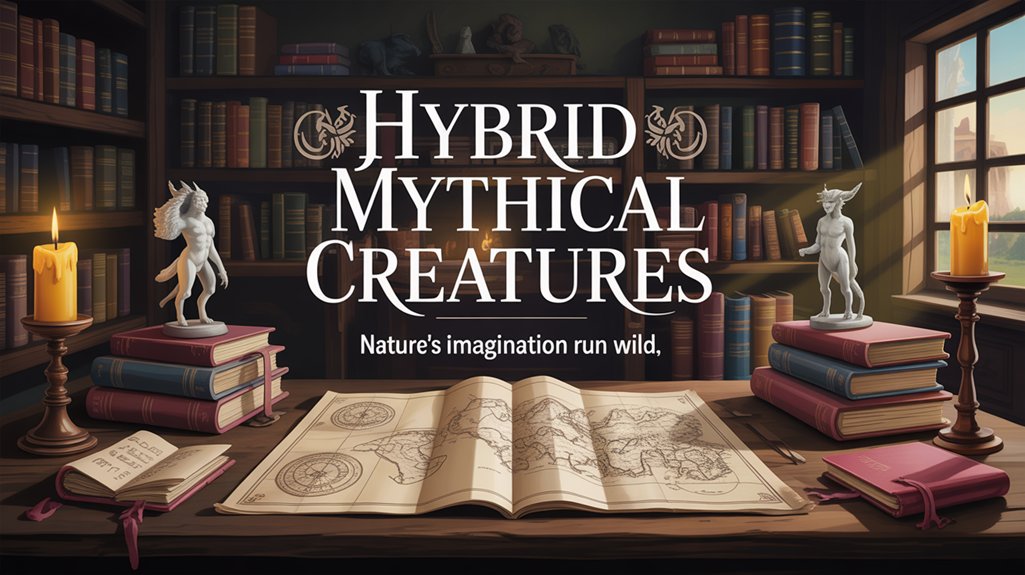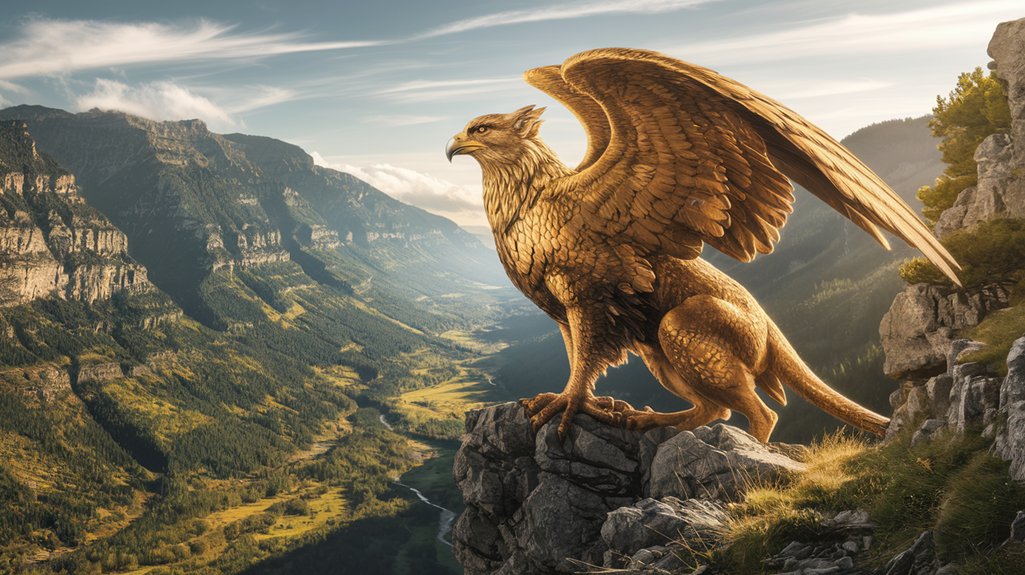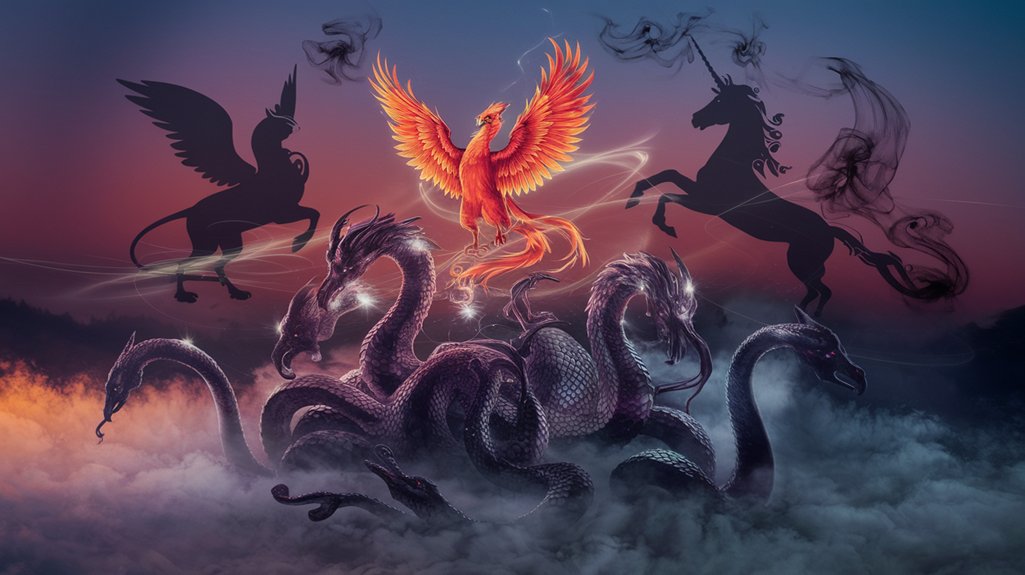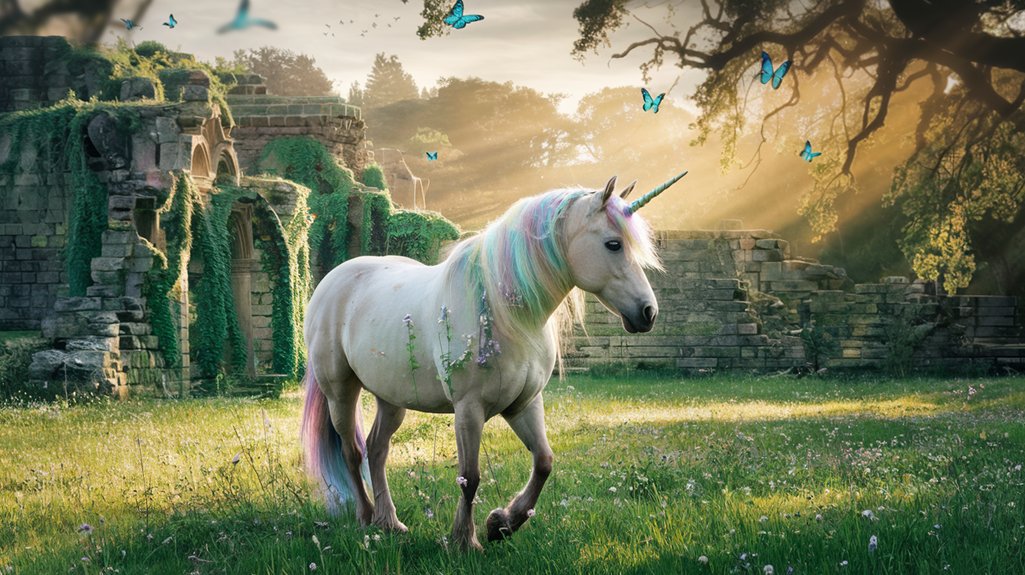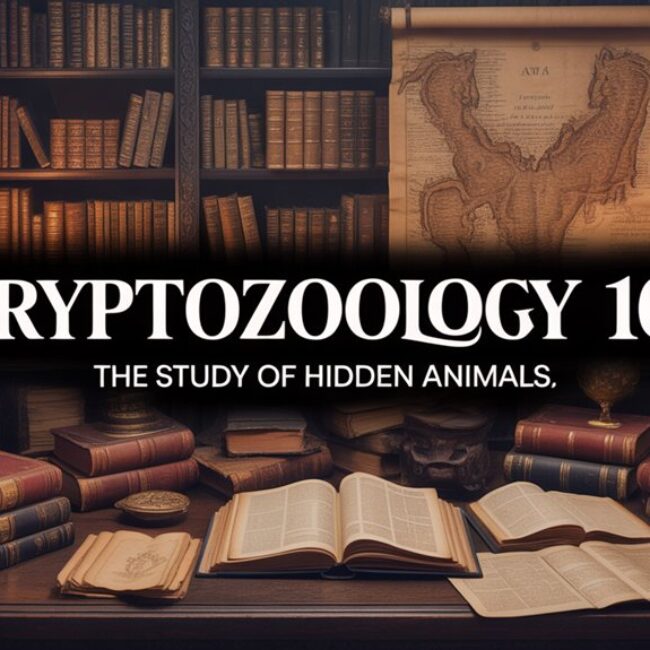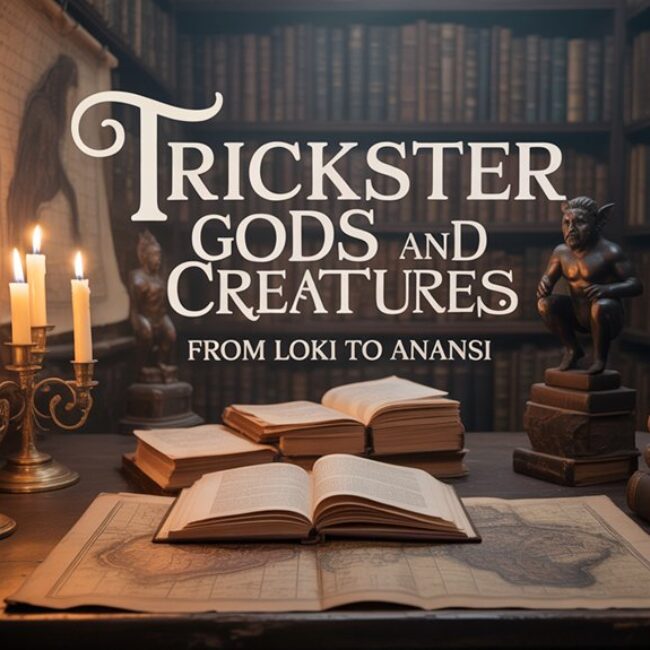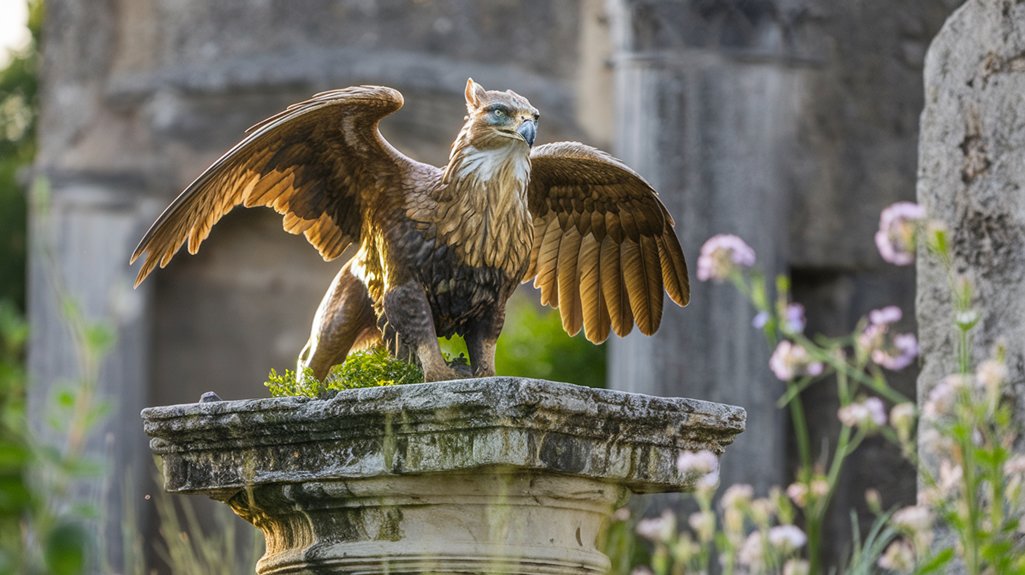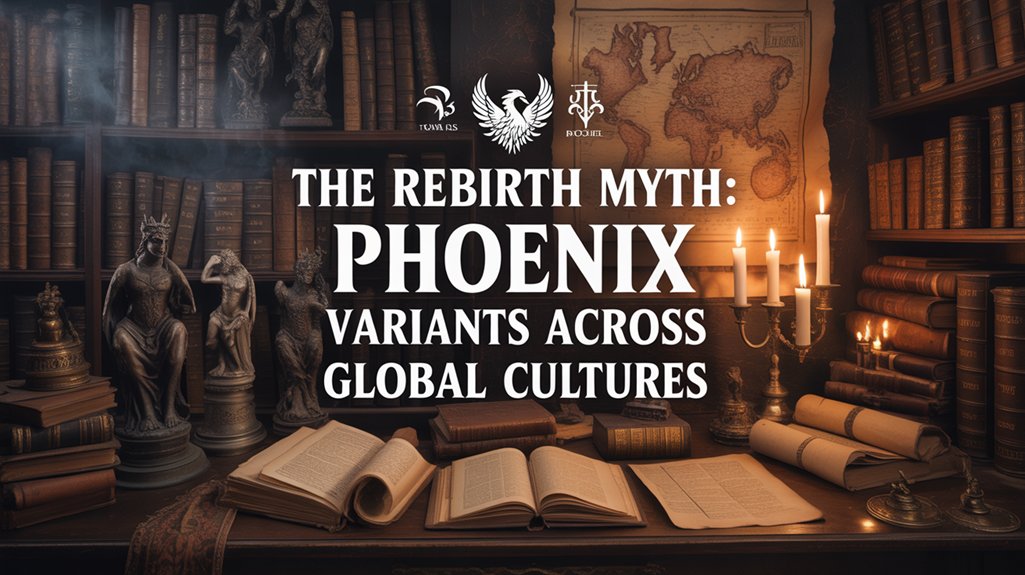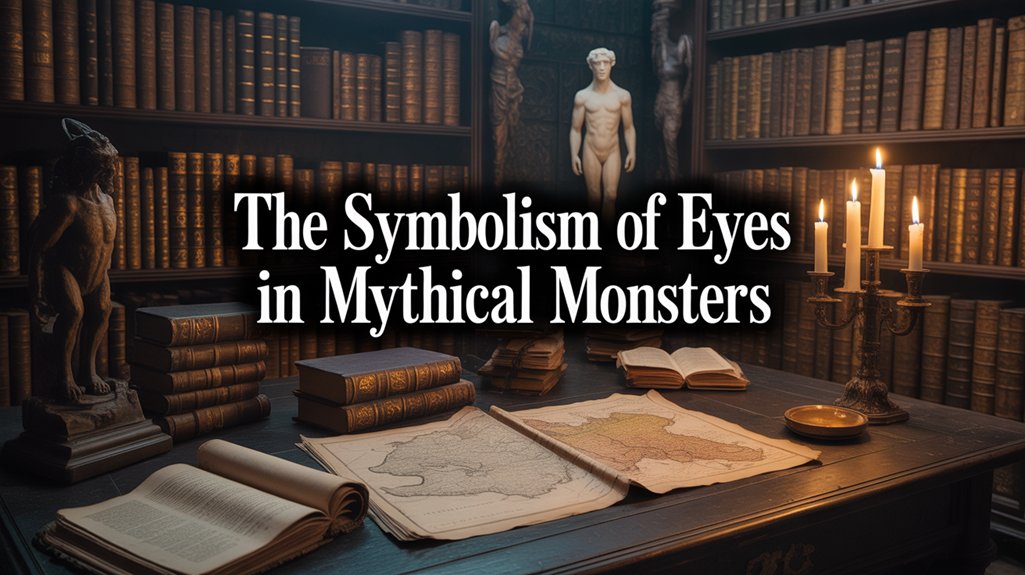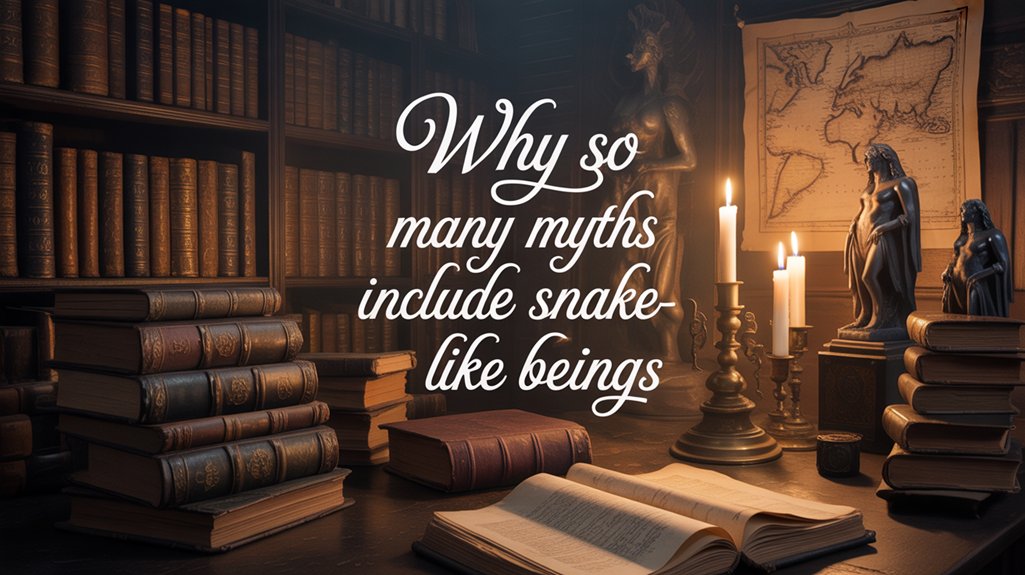
You’ve encountered hybrid creatures your entire life without recognizing their theological architecture—the chimeric entities that guard museum halls weren’t born from whimsy but from humanity’s ancient compulsion to cartograph boundaries between terrestrial order and cosmic chaos. The Chimera of Arezzo captures this perfectly: lion body signifying earthly sovereignty, goat head representing untamed wilderness, serpent tail embodying regeneration. These composite beings—from Egyptian Ammit to Chinese Qilin—served as liminal guardians between mortal and divine domains, their anatomies encoding cosmological truths that still resonate through modern genetic engineering debates and fantasy media, awaiting those who venture deeper into their symbolic architecture.
Table of Contents
ToggleKey Takeaways
- Hybrid creatures like the Sphinx, Chimera, and Qilin emerged across civilizations to represent boundaries between mortal, divine, and bestial realms.
- The Chimera’s tripartite anatomy—lion, goat, serpent—symbolizes the tension between cosmic chaos and the fragility of natural order.
- Greek hybrids served philosophical purposes: Centaurs embodied rationality versus barbarism, while Minotaurs represented civilization’s struggle against primal rage.
- Modern genetic engineering with CRISPR echoes ancient hybrid mythology, raising ethical questions about humanity’s boundaries in creating life.
- Video games and fantasy media democratize hybrid creation, keeping ancient mythological traditions alive through interactive, playable chimeric entities.
Chimera: Lion-Goat-Serpent Fusion
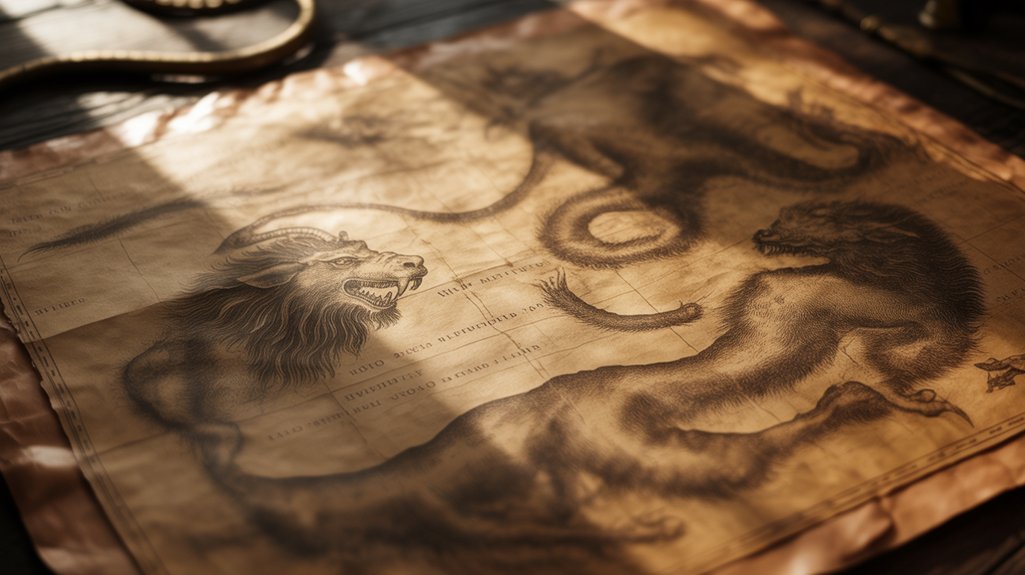
The Chimera emerges from the volcanic landscapes of ancient Lycia, circa 700 BCE, as one of Greece’s most eldritch composite beasts—a creature whose very anatomy defies natural law.
You’ll find its lion’s body crowned with a leonine head, while a goat’s head protrudes unnaturally from its spine, and a serpent writhes as its tail. Fire pours from its maw, embodying primordial chaos.
This hybrid mythology represents more than mere monster—it’s an omen of catastrophe, a living symbol of cosmic disorder.
Chimera symbolism resonates through millennia, depicting the dangerous fusion of opposing forces, the violation of nature’s boundaries. You can trace its influence from Bellerophon’s legendary aerial assault, mounted on Pegasus with his lead-tipped spear, to modern genetic science where “chimeric” organisms bear cells from multiple individuals.
The term itself has evolved, yet retains that ancient recognition: some combinations shouldn’t exist. Like other mythical creatures across cultures, the Chimera serves as a metaphor for humanity’s deepest anxieties about the unnatural and the transgressive.
They do anyway.
##
You’ll discover that hybrid creatures emerged independently across ancient civilizations, their chimeric forms reflecting humanity’s primal need to transcend categorical boundaries between beast, divine, and mortal.
From the leonine Sphinx guarding Egyptian tombs in the Third Dynasty (circa 2686 BCE) to the eldritch Qilin of Han Dynasty scrolls, these composite beings served as liminal guardians—thresholds between earthly and celestial domains.
The Greeks fashioned their Minotaur and Centaur, the Romans adopted and altered these hybrids into imperial symbols, while Asian traditions wove together serpentine dragons with avian phoenixes, each culture crafting sacred monsters that embodied their deepest cosmological truths.
Origins in Ancient Mythology
Across millennia and continents, ancient civilizations forged hybrid creatures from the primal elements of their natural world, weaving together disparate anatomies into singular, eldritch forms that transcended mere zoological classification.
You’ll find the Chimera embodying chaos through lion, goat, and serpent merged into one. The Egyptian Sphinx commanded thresholds—leonine strength fused with human consciousness, guardian of sacred mysteries.
Hindu tradition birthed Narasimha, divine protector manifesting as man-lion unity, demonstrating mythical symbolism through visceral embodiment of dharma’s triumph. Persian lore contributed the Manticore: human intelligence crowned upon predator’s muscle, scorpion’s venom completing its arsenal.
Each chimeric entity carried profound cultural significance, converting biological impossibility into spiritual necessity. These weren’t mere fantasies—they were civilization’s attempt to map the unmappable territories between known and unknown.
Greek and Roman Hybrids
Where Mediterranean civilizations carved their pantheons into marble and myth, Greek and Roman hybrid creatures emerged as sophisticated philosophical instruments—beings whose composite anatomies encoded complex dualities of human existence.
You’ll encounter the Chimera’s tri-fold anatomy: leonine ferocity, caprine sacrifice, serpentine cunning—a breathing sermon on nature’s eldritch possibilities.
The Minotaur’s bull-human form embodied civilization’s struggle against primal rage, trapped within labyrinthine stone.
Centaurs manifested dual nature itself, their chimeric bodies split between rational human thought and equine barbarism.
The Sphinx posed riddles at Thebes’ gates, its composite form wedding leonine strength to human wisdom.
Harpies descended as winged retribution, bird-bodied and woman-faced.
Pan emerged with horns and beard, born fully developed with goat-like features to shepherd Arcadia’s flocks—a deity whose rustic hybridity connected divine realms to pastoral wildness.
Each hybrid carried mythical symbolism deeper than mere monstrosity—philosophical treatises written in flesh, teaching you that humanity dwells eternally between opposing forces.
Egyptian Composite Deities
Along the Nile’s sacred banks, where death’s threshold merged with divine rebirth, Egyptian priests conceived composite deities whose zoomorphic anatomies transcended mere representation—they became theological architecture.
Khnum’s ram-crowned form spoke creation through potter’s wheels, while Bastet’s feline visage guarded domesticity’s sacred flame.
You’ll find deity symbolism most profound in Ammit—devourer of unworthy hearts, her crocodilian jaws, leonine torso, and hippopotamus haunches manifesting cosmic justice incarnate.
The Criosphinx stood sentinel with ram’s wisdom atop leonine strength, its chimeric form protecting temple thresholds.
These weren’t mere animal representations; they were eldritch equations, each hybrid anatomy encoding divine mathematics.
The gods demanded bodies that could hold multitudes, forms that shattered biological law to embody transcendent truth.
Theological necessity birthed monsters into meaning.
Asian Legendary Combinations
Beyond the Himalayan peaks where monsoon winds carried prayers skyward, Asian cosmologies birthed hybrid forms whose serpentine geometries mapped the relationship between earth and enlightenment.
Nü Wa symbolism embodied creation’s duality—her human torso and serpent coils weaving cosmic order from primordial chaos. Nāga representations coiled through temple reliefs, their chimeric bodies channeling aquatic abundance, protective guardians dwelling in subterranean palaces.
Garuda mythology soared above mortal concerns, eagle-crowned and human-bodied, this vahana bearing Vishnu across celestial battlefields with fierce devotion.
Buraq significance transcended earthly physics—human-faced, horse-bodied, winged—carrying prophetic consciousness through night’s eldritch dimensions.
Qilin characteristics merged dragon scales with deer grace, their auspicious presence heralding prosperity’s arrival.
These weren’t mere monsters. They were wisdom incarnate.
Homer’s Iliad, Book Six
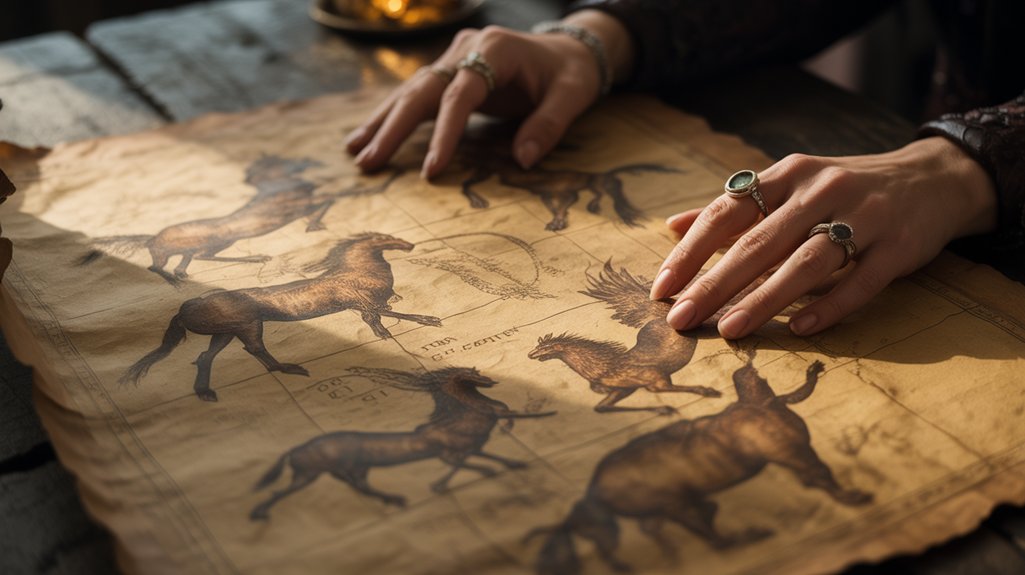
You encounter in Book Six a conspicuous absence—the Chimera herself, that tripartite horror born in Hesiod’s Theogony (line 319), doesn’t prowl the Trojan plains despite her prominence in Lycian mythology.
Yet Homer embeds this fire-breathing terror within the narrative’s sinews through Glaucus’s genealogical recitation, wherein he recounts how his grandfather Bellerophon slew the creature in ancient Lycia, that domain of Asia Minor where lion, serpent, and goat fused into one eldritch symbol of divine punishment.
The monster’s spectral presence haunts the text, reminding you that hybrid horrors need not materialize on the battlefield to shape the fates of warriors whose bloodlines carry the weight of chimeric encounters.
Hesiod’s Theogony, Line 319
While Hesiod’s *Theogony* catalogues the primordial genealogies of Greek divinity with systematic precision, line 319 marks an essential juncture where the poet introduces the Chimera—that most eldritch of composite beasts, born from the union of Echidna and Typhon.
You’ll discover how these primordial deities spawned creatures embodying chaos itself, their hybrid characteristics manifesting as lion’s mane, serpent’s tail, and goat’s torso united in impossible synthesis.
The text reveals humanity’s earliest attempts to comprehend nature’s transgressive boundaries, where divine bloodlines produced offspring defying categorization.
Here, in archaic Greek hexameter, you witness the blueprint for all subsequent chimeric beings: monsters as theological necessity, not aberration.
Hesiod understood what modernity often forgets—that hybridity represents cosmic truth, the fundamental instability underlying existence itself, forever resisting our taxonomic impulses.
Ancient Lycia, Asia Minor
The Chimera’s theological necessity found its geographic anchor in Lycia, that wild peninsula jutting into the Mediterranean where limestone crags pierce clouds and ancient tombs stare from cliff faces like hollow eyes. You’ll discover how Lycian mythology breathed life into this tripartite beast—lion, serpent, goat—a creature born from landscapes where reality itself fragments. Lycian geography demanded such eldritch manifestations.
| Lycian Element | Mythic Function | Geographic Parallel |
|---|---|---|
| Mountain Ranges | Chimera’s Domain | Volcanic territories |
| Rock-Cut Tombs | Underworld Portals | Death’s threshold |
| Coastal Boundaries | Liminal Zones | Sea-land convergence |
| Federal Democracy | Divine Order | Cosmic balance |
Homer’s warriors Sarpedon and Glaucus carried this chimeric consciousness to Troy. Ancient belief systems. Their federation mirrored celestial hierarchies, altering political freedom into theological imperative.
Fire-Breathing Terror Symbol
Bellerophon’s descent into Lycian territories marked the moment when human valor collided with primordial impossibility—that fire-breathing chimera whose very anatomy defied natural law.
You’re witnessing Homer’s most eldritch antagonist: leonine ferocity fronting the beast, caprine oddity erupting mid-spine, serpentine malice trailing behind.
Chimera symbolism transcends mere monster—it’s war’s unpredictable savagery made flesh, breathing literal flames across Lycian landscapes circa 1200 BCE.
This hybrid creature mythology captures your ancestors’ understanding that combat doesn’t follow rational patterns. The chimeric form merges incompatible elements into singular terror, reflecting battle’s chaotic nature where death strikes from unexpected angles.
You can’t predict which head will attack, which element will consume you. Ancient Greeks encoded their battlefield nightmares into this impossible anatomy, altering psychological horror into tangible myth.
Etruscan Chimera of Arezzo
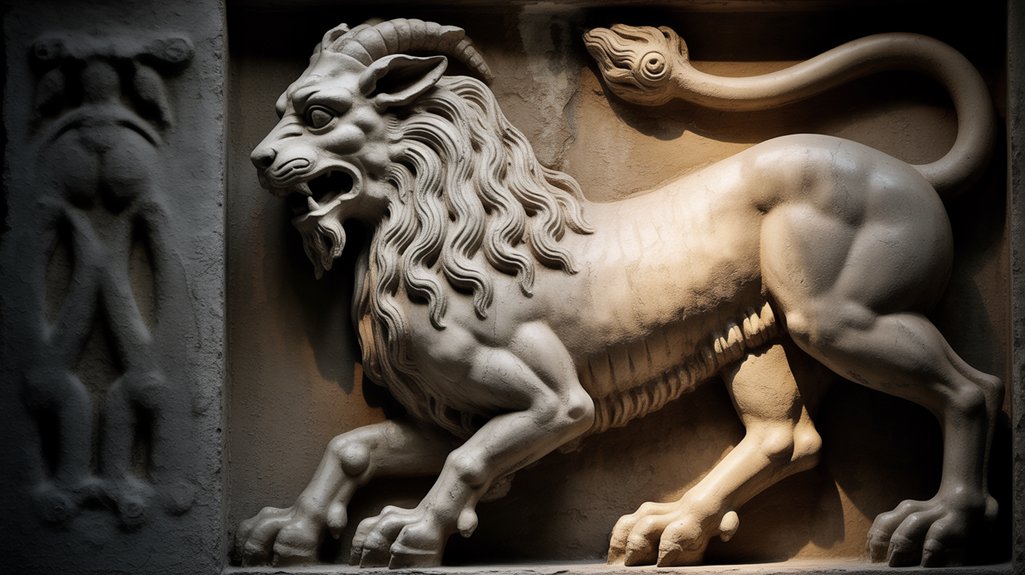
Bronze and fire birthed this eldritch monument in the 5th century BCE, a tribute to Etruscan artisans who understood the chimeric essence of existence itself. When you encounter the Chimera of Arezzo in Florence’s National Archaeological Museum, you’re witnessing Etruscan artistry that surpasses mere representation—this creature embodies chaos wrestling with cosmic order.
Discovered in 1553 within Arezzo’s ancient soil, the sculpture captures mythical symbolism through its tripartite form: leonine body prowling forward, caprine head erupting from muscled shoulders, serpentine tail coiling in perpetual strike. The vibrant pose reveals masters of bronze casting who knew movement, threat, alteration.
| Element | Physical Form | Symbolic Meaning |
|---|---|---|
| Lion Body | Dominant torso, powerful limbs | Earthly sovereignty, primal strength |
| Goat Head | Rising from back | Untamed wilderness, ascending chaos |
| Serpent Tail | Coiled, aggressive | Regeneration, cyclical destruction |
You witness freedom carved in metal—existence refusing singular definition, boundaries dissolved between beast and myth.
Chaos Versus Divine Order
When hybrid creatures stride across mythology’s threshold, they carry within their composite forms the eternal tension between primordial chaos and the structuring force of divine will.
You’ll find chaos symbolism embedded in the Chimera’s grotesque assemblage—lion, goat, serpent—a nightmare defying natural law. Yet divine representation emerges through Ganesha’s elephant-crowned wisdom, altering the monstrous into the sacred. This hybrid balance reveals humanity’s desperate need to impose meaning upon existence’s eldritch mysteries.
Cultural interpretations diverge wildly. The Minotaur embodies chaos unrestrained. The Lamassu guards civilization’s gates. Both chimeric. Both essential.
Consider these manifestations:
- Ammit’s Devourer weighs hearts against Ma’at’s feather, chaos serving divine judgment
- Griffin guardianship alters predatory fusion into protective order
- Sphinx riddles force intellectual mastery over bestial confusion
- Nagas’ serpentine divinity bridges underworld chaos with celestial hierarchies
- Centaurs’ duality splits wisdom from violent abandon, never reconciled
You’re witnessing humanity’s cartography of the unknowable.
Bellerophon’s Heroic Slaying Quest
You encounter in Bellerophon’s quest the archetypal confrontation between mortal ingenuity and chimeric abomination—a fire-breathing hybrid whose leonine head, caprine torso, and serpentine tail embodied the chaotic amalgamation of disparate natures.
Athena’s intervention proved essential, her golden bridle converting Pegasus from untamed divine beast into aerial mount, granting the hero access to the vertical dimension his earthbound adversary couldn’t exploit.
Through strategic aerial assault, launching volleys from above while the Chimera’s flames scorched only empty air, Bellerophon achieved what ground-level warriors couldn’t—the systematic dismantling of triple terror through geometric advantage.
The Chimera’s Triple Terror
Though lesser beasts might lurk in shadowed grottos or prowl forgotten mountain passes, the Chimera commanded the terrified attention of ancient Lycia with its threefold monstrosity—a creature whose very form defied natural law.
You’ll find in this eldritch amalgamation the ultimate Chimera symbolism: leonine ferocity crowned its shoulders, caprine cunning twisted through its spine, serpentine malice writhed from its haunches. Each head breathed destruction independently, yet synchronized in terrible purpose.
The heroic narrative demanded aerial intervention. Bellerophon, astride Pegasus, altered vertical space into tactical advantage—you’d recognize this innovation as groundbreaking warfare.
His triumph wasn’t mere monster-slaying; it represented humanity’s refusal to accept chimeric impossibility, to bow before nature’s darkest experiments. Freedom achieved through audacity. Through wings. Through fire met with steel.
Pegasus: Divine Winged Ally
Blood-price paid in decapitation birthed the impossible—from Medusa’s severed neck, where Perseus’s harpe had carved through scale and sinew, Pegasus erupted skyward in defiance of mortal comprehension.
You’ll find this eldritch stallion became Bellerophon’s instrument against the Chimera’s flame-scorched terror, his wings granting tactical supremacy over that tripartite abomination. Freedom incarnate, white pinions catching Olympian thermals.
The divine mount transcended mere utility—his mythical symbolism evolved into humanity’s yearning for transcendence, for breaking terrestrial shackles. Zeus recognized this power, elevating Pegasus beyond mortality’s grasp into celestial representation itself. Constellation. Eternal.
The hero fell from hubris, yet his winged ally soared onward, forever mapped across autumn skies, reminding you that while flesh falters, the aspiration toward liberation endures. Immortalized starlight bears witness.
Victory Through Strategic Combat
When King Iobates received the sealed tablet from Proitos—a death warrant disguised as hospitality’s obligation—he understood the political calculus demanded impossible labor rather than direct assassination.
Consequently emerged Bellerophon’s assignment: confront the eldritch Chimera, that chimeric abomination breathing devastation across Lycia’s borderlands. The hero’s mythic strategy altered aerial combat itself.
Mounted upon divine Pegasus, he claimed the sky’s domain, circling beyond the creature’s fiery exhalations, raining arrows into vulnerable flesh below. This tactical advantage—vertical supremacy against earthbound monstrosity—marked warfare’s evolution within heroic tradition.
Athena’s guidance sharpened his approach further, divine wisdom merged with mortal courage. The Chimera fell.
Yet Iobates, unsatisfied, dispatched him against Solymi warriors, then Amazon legions. Each victory reinforced an essential truth: strategic brilliance transcends brute force, freedom demands calculated defiance against tyrannical expectation.
Video Games and Fantasy Literature
As digital domains have expanded the boundaries of interactive storytelling, hybrid mythical creatures have evolved from static descriptions in ancient texts into fluid, playable entities that challenge our understanding of chimeric possibility.
You’ll discover fantasy hybrids manifesting through character evolution systems that honor ancient archetypes while forging unprecedented paths of agency. The Dragonborn embodies thu’um-wielding sovereignty, merging mortal flesh with draconic essence. Driders emerge from eldritch punishment, altering Drow nobility into arachnid abominations. These manifestations grant you liberation from singular identity constraints.
- The Chimera’s tripartite form represents chaos incarnate, defying taxonomic order through leonine, caprine, and serpentine fusion.
- Manticore mythology channels Persian origins into spell-weaving predators that transcend mere bestiality.
- Dracotaurs offer class-based exploration, combining reptilian majesty with centauroid mobility.
- Dungeons & Dragons’ hybridization mechanics democratize mythological creation, enhancing your imagination.
- Final Fantasy’s character systems weaponize alteration, treating metamorphosis as narrative birthright.
Modern Genetic Hybridization Studies
Beyond mythological archives and digital fantasias, contemporary laboratories harbor their own chimeric ambitions—though these emerge not from divine caprice but from deliberate nucleotide manipulation.
You’ll find CRISPR-Cas9 wielding the precision ancient alchemists dreamed of, splicing genetic sequences with surgical intent. Scientists conjure disease-resistant crops—Bt corn, Roundup Ready soybeans—hybrid organisms engineered for survival in hostile terrains. This isn’t fantasy. These chimeras walk among us, reshaping agricultural landscapes, pharmaceutical frontiers.
Yet such power demands scrutiny. Genetic diversity becomes both tool and concern; introducing modified hybrids into natural ecosystems risks disrupting evolutionary trajectories millennia in the making.
Conservation biologists invoke hybrid vigor to rescue endangered populations from extinction’s threshold, while ethicists wrestle with profound questions: What boundaries should constrain our creative impulses? The ethical implications echo ancient warnings against hubris, reminding us that freedom to create carries responsibility.
These modern chimeras, born from microscopic interventions rather than godly whim, force confrontation with humanity’s role as both creator and guardian.
Cultural Fear of Boundary-Breaking
Throughout millennia, hybrid creatures have occupied humanity’s darkest imaginative territories—those eldritch domains where category collapses into category, where beast merges with human, where the ordered cosmos fractures into bewildering possibility.
You’ll find that mythical hybrids like the Chimera and Minotaur weren’t merely fantastical inventions but profound expressions of cultural anxieties about violated boundaries. These chimeric beings represented dangerous transgressions against divine ordinances, natural hierarchies, and societal structures that kept chaos at bay.
When you examine ancient Greek, Egyptian, and Mesopotamian traditions, you’ll discover that hybrid forms consistently symbolized forbidden knowledge, hubris, and nature’s retribution. The fear wasn’t irrational superstition—it reflected genuine philosophical concerns about identity, morality, and humanity’s proper place within creation’s architecture.
Today, you’re witnessing these ancient terrors resurface in genetic engineering debates. The specter of laboratory-created hybrids evokes primordial warnings: some boundaries exist for humanity’s protection. Cross them, and you risk releasing consequences beyond comprehension or control.
Legacy in Modern Media
Where ancient terrors once prowled solely through oral tradition and temple friezes, they’ve now infiltrated your screens, controllers, and virtual realities—changing yet again to haunt contemporary consciousness.
These chimeric entities demand your attention across transmedia landscapes: Dungeons & Dragons resurrects Chimeras and Manticores, granting players agency to encounter what once inspired dread. Pokémon converts hybrid taxonomy into collectible wonder. Cultural adaptations permeate every medium.
The Legend of Zelda positions you within worlds where boundary-breaking creatures establish atmospheric tension. Dark Souls weaponizes their eldritch presence against your survival instincts. Avatar: The Last Airbender weaves dragon-human amalgamations into systematic world-building, while The Dragon Prince continues this narrative evolution, treating hybridity as philosophical inquiry rather than aberration.
You witness mythology’s persistence—not fossilized, but breathing through digital interfaces. These franchises liberate ancient archetypes from academic confinement, democratizing access to sacred knowledge.
The hybrids endure because they speak to your unbound imagination, your refusal to accept rigid categories, your recognition that alteration itself holds power.
Frequently Asked Questions
What Other Hybrid Creatures Appear in Greek Mythology Besides the Chimera?
You’ll discover the Sphinx—lion-bodied, eagle-winged, bearing a woman’s face—whose Sphinx symbolism embodies riddles and divine judgment at Thebes’ gates.
The Minotaur origins trace to Crete’s labyrinth, where Pasiphaë’s cursed union birthed this bull-headed man.
Harpies torment with avian fury, their talons sharp as prophecy.
The Gryphon guards treasures, merging lion and eagle in eldritch majesty.
Scylla’s six serpentine heads devour sailors, while Centaurs—half-horse, half-human—roam Thessaly’s wilderness, embodying humanity’s untamed nature.
Are There Chimera Myths in Non-European Cultures and Ancient Civilizations?
You’ll discover chimeric beings aren’t Europe’s monopoly—though Western scholars love claiming monster-making supremacy.
Asian chimeras like China’s Qilin (龍麟), melding dragon scales with deer grace, emerged during the Zhou Dynasty’s eldritch court rituals.
African hybrids prove equally sophisticated: Egypt’s Ammit, devouring unworthy souls with crocodilian jaws, leonine torso, hippopotamus haunches, stalked judgment halls millennia before Greek poets conceived their fire-breathing composite.
These entities transcend mere fantasy—they’re sacred guardians embodying cultural wisdom you’re free to explore beyond Eurocentric narratives.
How Do Modern Scientists Create Genetic Chimeras in Laboratory Settings?
You’ll find modern scientists wield genetic engineering techniques to manifest chimeric beings through embryonic cell fusion, blastocyst injection, and precise CRISPR interventions.
These laboratory techniques merge disparate genetic lineages—mouse neurons within rat brains, human cells colonizing porcine organs—transcending nature’s ancient boundaries.
Through microinjection and viral vectors, researchers orchestrate what mythology once whispered: the fusion of separate essences into singular, transgressive forms.
Freedom from biological constraint births organisms straddling species borders, scientific chimeras echoing humanity’s eldritch dreams.
What Psychological Factors Make Humans Fascinated by Impossible Animal Combinations?
You’re drawn to chimeric beings because they embody symbolic representation of your deepest fears, desires, metamorphosis.
Your mind, seeking pattern, meaning, purpose, finds cultural significance in these eldritch combinations—the sphinx merging human wisdom with leonine strength, the griffin uniting earth and sky.
These impossible creatures reflect your own liminal nature, your yearning to transcend boundaries.
Ancient civilizations understood: hybrid forms map the soul’s complexity, its refusal of simple categories, its wild multiplicity.
Which Video Games Feature the Most Accurate Depictions of Mythical Chimeras?
You’ll find mythological accuracy in *Assassin’s Creed Odyssey*, where chimeric beasts emerge from authentic Hellenic sources—the Sphinx poses riddles, the Minotaur stalks Knossos’s labyrinth.
*Shin Megami Tensei* honors global traditions: Japanese baku, Mesopotamian lamassu, each rendered through scholarly research.
*God of War* presents Greek chimeras with archaeological precision.
These video game examples transcend entertainment, becoming digital grimoires where ancient wisdom breathes. They’re portals to lost knowledge, treating mythological creatures not as fantasy but as cultural memory preserved through interactive ritual.
Conclusion
You stand at the threshold where lion bleeds into serpent, where boundaries dissolve. The chimera symbolizes your deepest unease—not mere monsters, but the eldritch truth that categories fail, that nature refuses your taxonomies. These hybrid forms persist because you cannot escape liminality itself. In laboratories and fantasy domains alike, the chimeric impulse endures, whispering that change, not stasis, defines existence. You’re already crossing borders you didn’t know existed.

